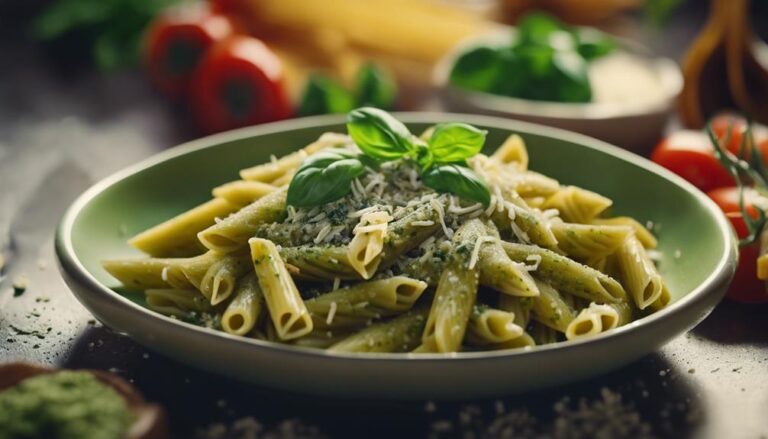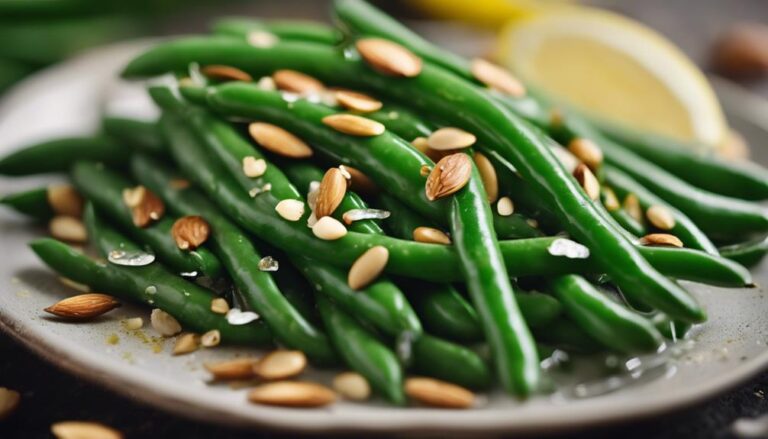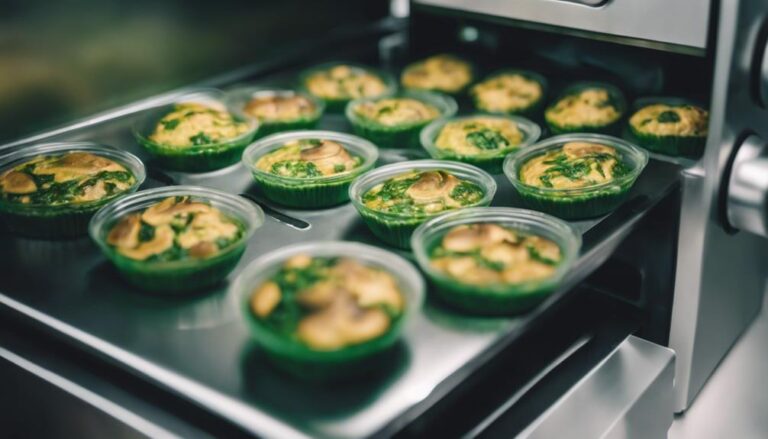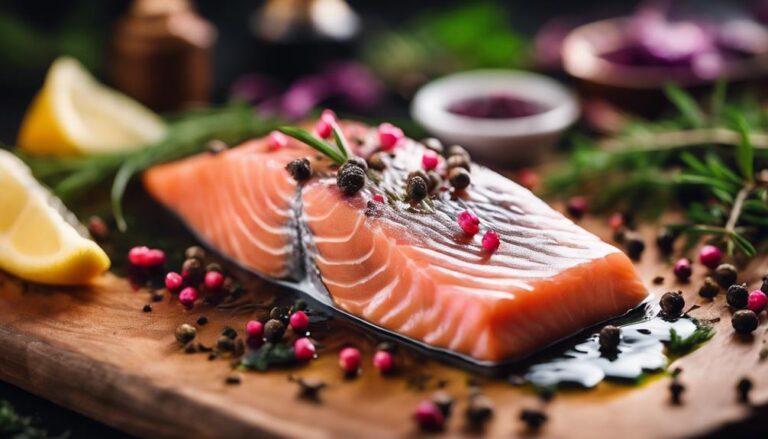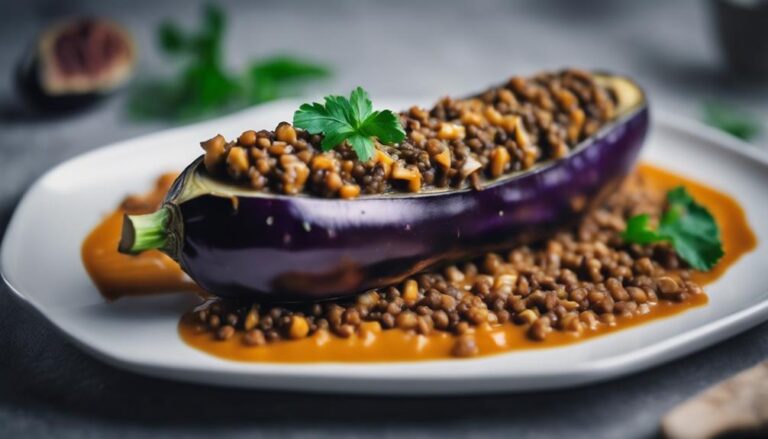Sous Vide Rhubarb Crumble With Oat Streusel
Achieve a perfect fusion of sous vide cooking and rhubarb tanginess in your crumble with oat streusel. Enhance flavor while preserving rhubarb's integrity through precise cooking. The vibrant tartness of rhubarb complements the crunchy oat topping beautifully. Explore this modern twist on a classic dessert for a delightful harmony of taste and texture. Master the balance of sweetness and tang in each bite to elevate your culinary creations. Discover how sous vide technique enhances not just flavor but visual appeal too. Uncover the secrets to achieving the perfect symphony of flavors waiting for you.
What You Will Learn Here
- Sous vide cooking preserves rhubarb's integrity and enhances flavor.
- Oat streusel topping adds crunch and fiber to the dessert.
- Achieve the perfect balance of sweetness and tartness in the crumble.
- Customize topping with nuts, spices, or coconut for unique flavors.
- Focus on achieving a golden brown bake for visual appeal.
Origin of Rhubarb's Culinary Use
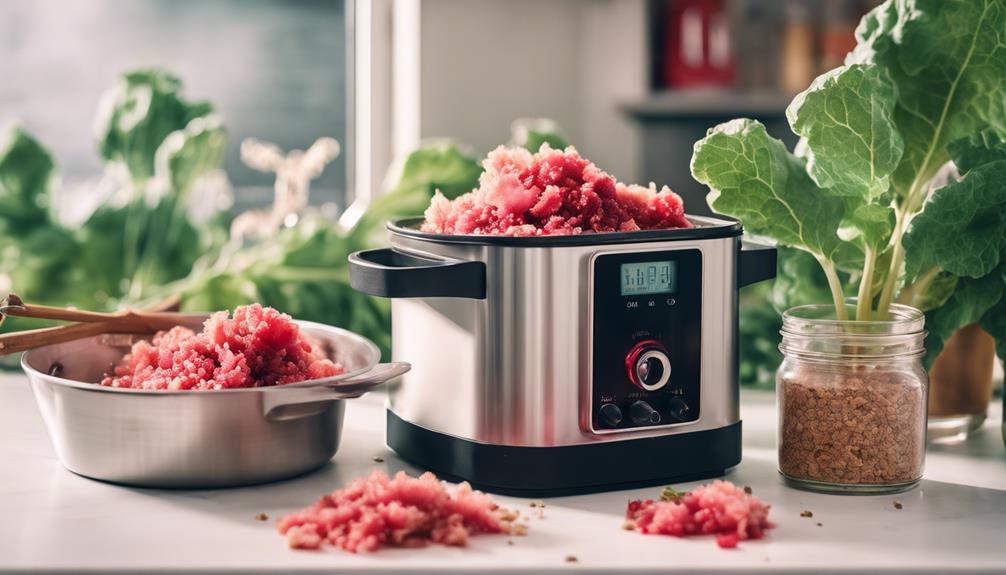
Rhubarb's culinary journey began in ancient China for medicinal purposes, evolving into a popular ingredient in European cuisine during the 18th century.
This metamorphosis marked a significant shift in rhubarb's usage from medicinal herb to culinary delight.
Today, rhubarb's tangy flavor is a versatile component in both traditional and modern dishes.
Culinary History of Rhubarb
Having originated in Asia, particularly in regions such as China and Mongolia, rhubarb found its culinary purpose after being initially cultivated for its medicinal properties. As the plant made its way to Europe in the 18th century, it started gaining popularity as a dessert ingredient. The 19th century saw a significant expansion in the culinary use of rhubarb, especially in sweetened recipes like pies and crumbles. Rhubarb's tart flavor profile and vibrant color have rendered it a versatile ingredient that can be used in both sweet and savory dishes.
| Culinary History of Rhubarb | |
|---|---|
| Origin | Asia: China, Mongolia |
| Introduction to Europe | 18th century |
| Popular Dessert Ingredient | Pies, Crumbles |
| Versatility | Sweet and Savory dishes |
Rhubarb in Traditional Dishes
Originating in Asia, particularly in regions like China and Mongolia, rhubarb has a rich culinary history dating back centuries. Initially prized for its medicinal qualities, rhubarb later found its way into traditional dishes, including the beloved rhubarb crumble.
In Europe during the 18th century, rhubarb became a staple in desserts like pies, crisps, and crumbles, where its tartness provided a delightful contrast to the sweetness of the dishes. The vibrant red color and tangy taste of rhubarb have made it a favorite ingredient in traditional recipes worldwide.
Whether you're baking a rhubarb crumble or experimenting with new ways to incorporate this versatile ingredient, it's easy to see why people love rhubarb for its unique flavor profile.
Modern Rhubarb Culinary Trends
With a rich history dating back centuries, the culinary use of rhubarb has evolved to embrace modern trends that highlight its unique flavors and textures in innovative ways, such as sous vide cooking. Chefs and home cooks are increasingly turning to modern techniques like sous vide to reveal rhubarb's full potential, enhancing its natural tartness and texture. Below is a table showcasing the modern culinary trends involving rhubarb:
| Culinary Trend | Description | Benefits |
|---|---|---|
| Sous Vide Rhubarb | Utilizes vacuum-sealed bags to cook rhubarb at precise temperatures, enhancing flavor and texture. | Preserves nutrients and intensifies taste. |
| Rhubarb Infused Cocktails | Incorporates rhubarb syrup or juice in cocktails for a unique tart twist. | Adds complexity and depth to beverages. |
| Rhubarb Salsa | Combines diced rhubarb with ingredients like onions, tomatoes, and cilantro for a tangy salsa. | Provides a invigorating and unexpected flavor profile. |
Rhubarb's Unique Tart Flavor

Rhubarb's distinctive tartness distinguishes it as a standout ingredient in culinary creations. When exploring rhubarb's unique tart flavor, consider the following:
- Balance of Sweet and Tart: Rhubarb's tartness is a result of malic acid and oxalic acid, providing a sharp contrast to the sweetness of other ingredients in desserts.
- Invigorating Element: The tartness of rhubarb adds an invigorating element to dishes, awakening the palate with its zesty profile.
- Versatility in Culinary Applications: Rhubarb's tart flavor makes it a versatile ingredient in both sweet and savory dishes, offering a tangy kick to recipes like sauces, compotes, and beverages.
- Nutritional Benefits: Beyond its taste, rhubarb's tartness comes with a nutritional punch, as it's a good source of vitamins, minerals, and antioxidants, contributing to overall health and well-being.
Understanding rhubarb's unique tart flavor can elevate your culinary creations, bringing a delightful balance of acidity and sweetness to your dishes.
Rhubarb Crisp Variations
To explore the variety of rhubarb crisp variations, consider trying the Tangy Rhubarb Crisp Recipe, the Zesty Rhubarb Crisp Recipe, or the Crispy Rhubarb Streusel Topping. These variations offer different flavor profiles and textures that can enhance your culinary experience.
Experiment with adjustments like swapping ingredients for dairy-free or gluten-free options to cater to specific dietary preferences.
Tangy Rhubarb Crisp Recipe
Enhancing the classic tangy rhubarb crisp recipe with variations allows for a versatile and customizable dessert experience.
- Fruit Combinations: Experiment with different fruit combinations such as adding strawberries or apples to complement the rhubarb flavor.
- Nutty Twist: Incorporate chopped nuts like almonds or pecans into the oat streusel for added crunch and richness.
- Spice Infusion: Elevate the flavor profile by introducing spices like nutmeg or ginger to the rhubarb filling.
- Citrus Zest: Brighten up the dish with a touch of citrus zest such as lemon or orange to balance the tanginess of the rhubarb.
Zesty Rhubarb Crisp Recipe
Incorporating zesty citrus flavors into the traditional rhubarb crisp recipe provides an invigorating twist that elevates the dessert's overall taste profile.
When experimenting with a zesty rhubarb crisp recipe, consider the following variations:
- Rhubarb and Apple: Combining the tartness of rhubarb with the sweetness of apples adds depth to the flavor profile.
- Citrus Zest: Grating lemon or orange zest into the oat streusel topping enhances the dessert with a fresh and vibrant taste.
- Vanilla Ice Cream: Serving the zesty rhubarb crisp warm with a scoop of creamy vanilla ice cream creates a delightful contrast of temperatures and textures.
- Balancing Flavors: Adjusting the sugar levels to balance the tanginess of the rhubarb with the sweetness of the crumble guarantees a harmonious blend of flavors.
Crispy Rhubarb Streusel Topping
Creating a crispy rhubarb streusel topping involves combining oats, flour, sugar, and butter to achieve a perfect balance of textures and flavors for your rhubarb crisp. Here are some key points to keep in mind when making this delightful topping:
- Crunchy Goodness: The crispy streusel topping provides a delightful crunch that contrasts with the soft, cooked rhubarb underneath.
- Texture Harmony: The combination of oats, flour, sugar, and butter creates a texture that complements the cooked rhubarb filling.
- Customizable Flavors: Experiment with spices like cinnamon or nutmeg to enhance the streusel topping's flavor profile.
- Balancing Act: The crispy streusel plays an important role in balancing the tender cooked rhubarb, creating a harmonious dessert experience.
Baking Rhubarb Crisp Perfectly
When baking rhubarb crisp, make sure to evenly distribute the oat streusel topping over the fruit mixture for consistent baking.
Adjusting the baking time based on your oven's performance can help achieve a perfectly golden and crispy topping.
Monitoring the fruit's bubbling and texture will indicate when the rhubarb crisp is ready to be removed from the oven.
Baking Tips for Rhubarb
To guarantee your rhubarb crisp bakes perfectly, slice the rhubarb evenly for consistent texture and doneness throughout. When preparing the rhubarb, remember to mix it with brown sugar to enhance its natural tartness and create a deliciously sweet filling. Adjust the sugar levels in the recipe based on the fruit's sweetness, balancing it with the tartness of the rhubarb. To maintain the ideal texture, toss the rhubarb with cornstarch to thicken the juices during baking. Here is a table summarizing the key points:
| Baking Tips for Rhubarb |
|---|
| Slice rhubarb evenly |
| Mix with brown sugar |
| Adjust sugar levels |
| Balance sweetness and tartness |
| Add cornstarch for thickening |
Crispy Oat Streusel Topping
For achieving an impeccable rhubarb crisp, consider incorporating a finely textured oat streusel topping to enhance the dessert's overall crunchiness and flavor profile. The oat streusel topping plays an essential role in creating a crispy texture that contrasts beautifully with the soft rhubarb filling.
Oats, a key component of the streusel, not only contribute to the crispiness but also add a wholesome, fiber-rich element to the dish. Typically made with oats, flour, sugar, and butter, this topping blends harmoniously to provide a delicious flavor profile.
To elevate the streusel further, you can customize it by adding nuts, spices, or coconut for additional flavor dimensions and texture variations. Experimenting with different ingredients can offer a unique twist to your rhubarb crisp, making each bite a delightful experience.
Perfect Rhubarb Crisp
Achieving the perfect rhubarb crisp involves mastering the balance between a tender, cooked rhubarb filling and a golden, crunchy streusel topping. To guarantee your rhubarb crisp turns out just right, focus on achieving a perfect balance between the sweetness of the filling and the crispiness of the streusel. Here's a table to guide you through baking the perfect rhubarb crisp:
| Rhubarb Filling | Oat Streusel Topping | Baking Time |
|---|---|---|
| Adjust sweetness | Ensure crisp texture | Bake until golden brown |
| Cook to tender | Perfect balance | Filling is bubbling |
Final Thoughts
Considering the meticulous balance of textures and flavors in this Sous Vide Rhubarb Crumble Recipe, it's evident that precision in cooking techniques truly enhances the dessert experience. The controlled temperature of sous vide cooking guarantees that the rhubarb maintains its integrity, resulting in a tender yet firm texture that bursts with flavor. The oat streusel, with its crisp and buttery notes, complements the rhubarb perfectly, offering a delightful contrast in every spoonful.
When you remove the foil from the sous vide bag and witness the vibrant hues of the rhubarb, lightly coated in its natural juices, you can't help but appreciate the attention to detail that this cooking method provides. The visual appeal of the dish is just a precursor to the symphony of tastes that await your palate.
Frequently Asked Questions
Why Is My Rhubarb Crumble Soggy?
To prevent sogginess in your rhubarb crumble, make sure you thicken the fruit mixture with cornstarch or flour. Incorporating a layer of breadcrumbs or nuts can absorb excess liquid. Letting it cool post-bake aids in texture.
How Many Calories Are in a Rhubarb Crumble?
For a typical serving of rhubarb crumble, the calorie count ranges from 250-300. The nutritional value varies based on portion size and ingredients used. Enjoy in moderation to indulge without greatly affecting your intake.
Is Rhubarb Free on Slimming World?
Yes, rhubarb is free on Slimming World. It's a 'speed' food, allowing unlimited consumption without syn counting. When used in Slimming World-friendly desserts like rhubarb recipes or crumbles with oat streusel, it adds flavor while supporting weight loss goals.
Can You Freeze Uncooked Rhubarb Crisp?
Yes, you can freeze uncooked rhubarb crisp for later convenience. Wrap it tightly in plastic or store in an airtight container before freezing. Thaw in the fridge before baking for even cooking. Preserve freshness and flavor.
Conclusion
To sum up, sous vide cooking provides a precise method for creating a delicious rhubarb crumble with oat streusel.
The controlled temperature and sealed environment guarantee that the rhubarb retains its unique tart flavor while the oat streusel topping adds a satisfying crunch.
By following the proper techniques for sous vide cooking and baking, you can enjoy a perfectly balanced and flavorful dessert that will impress any palate.






